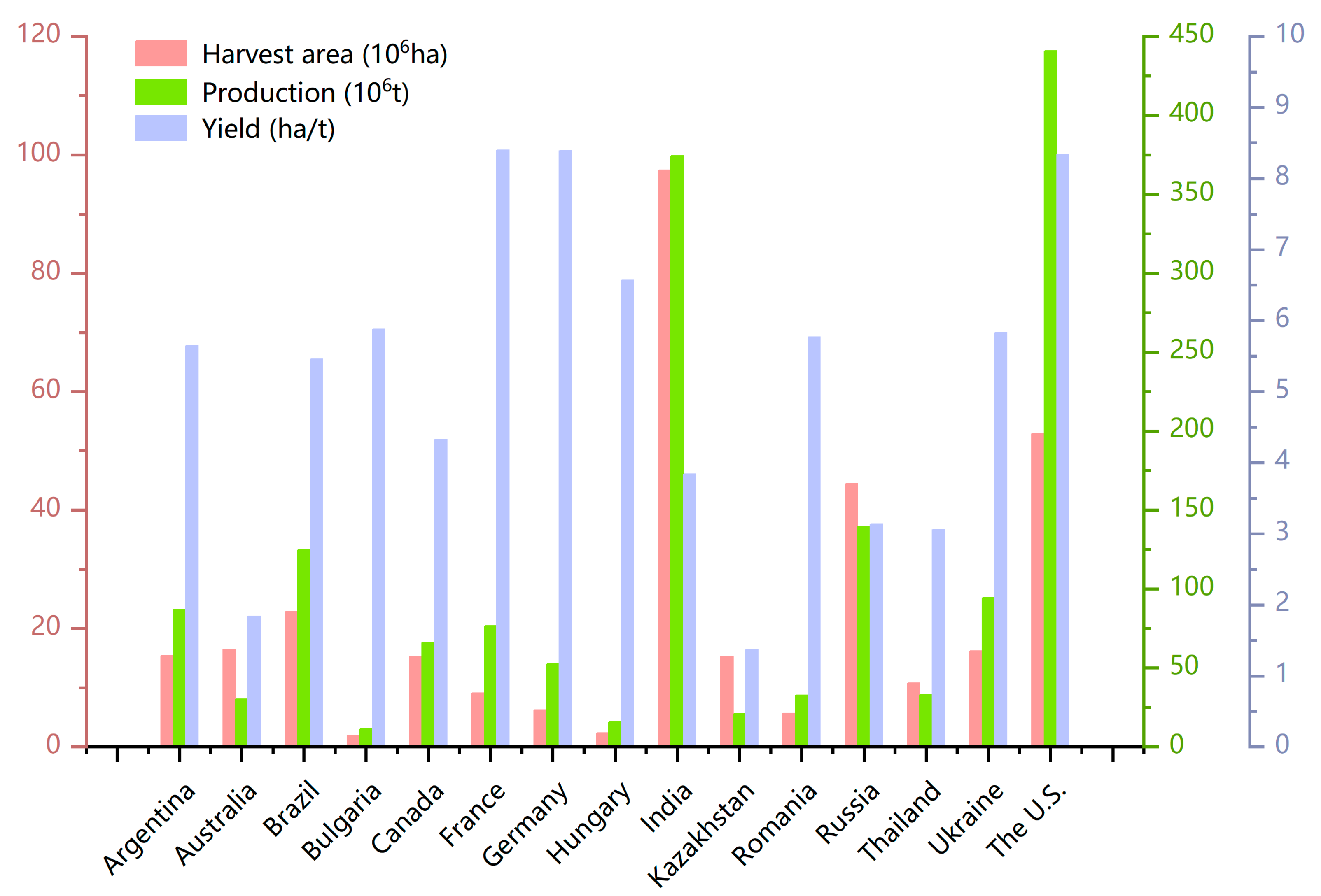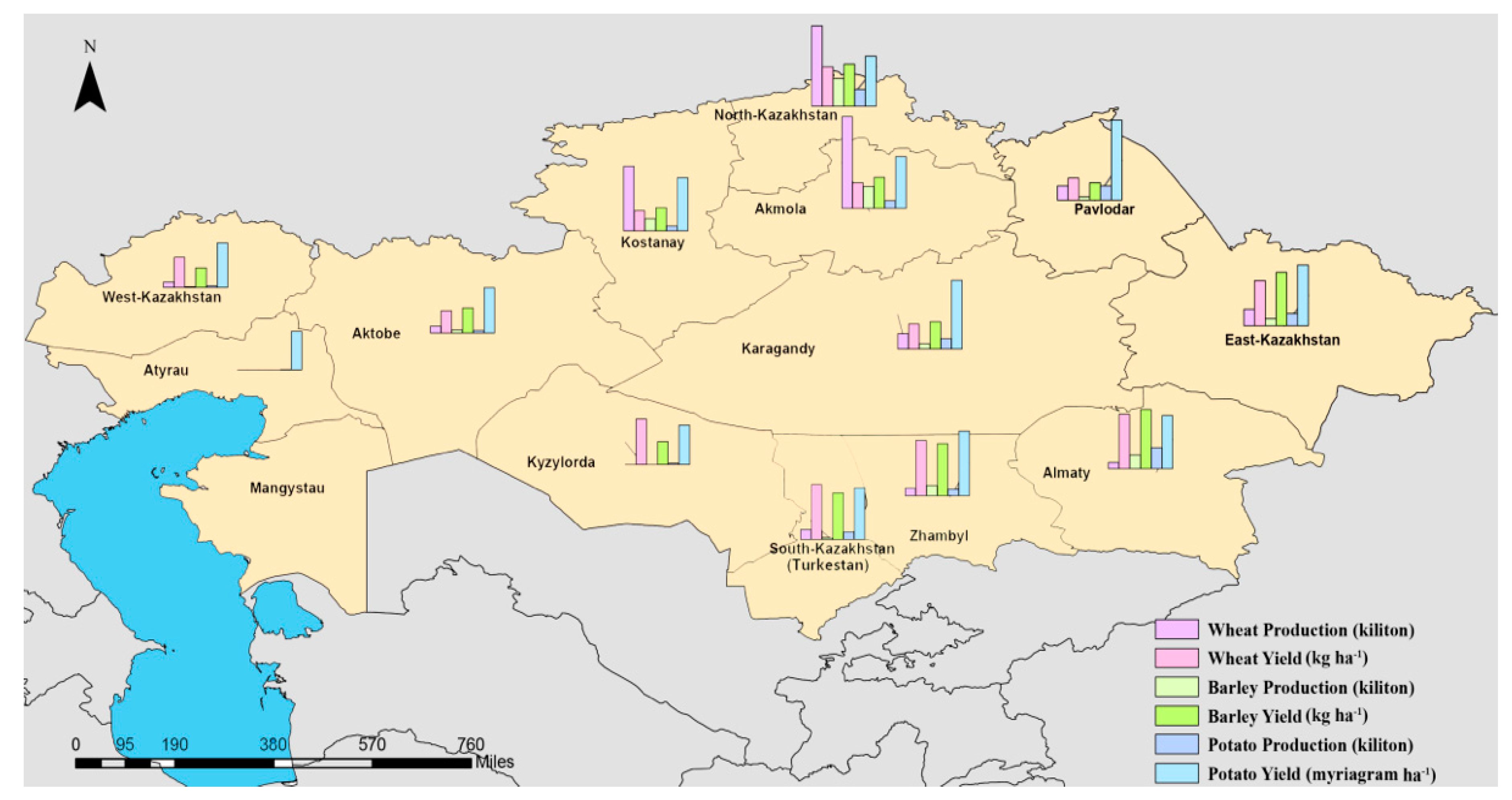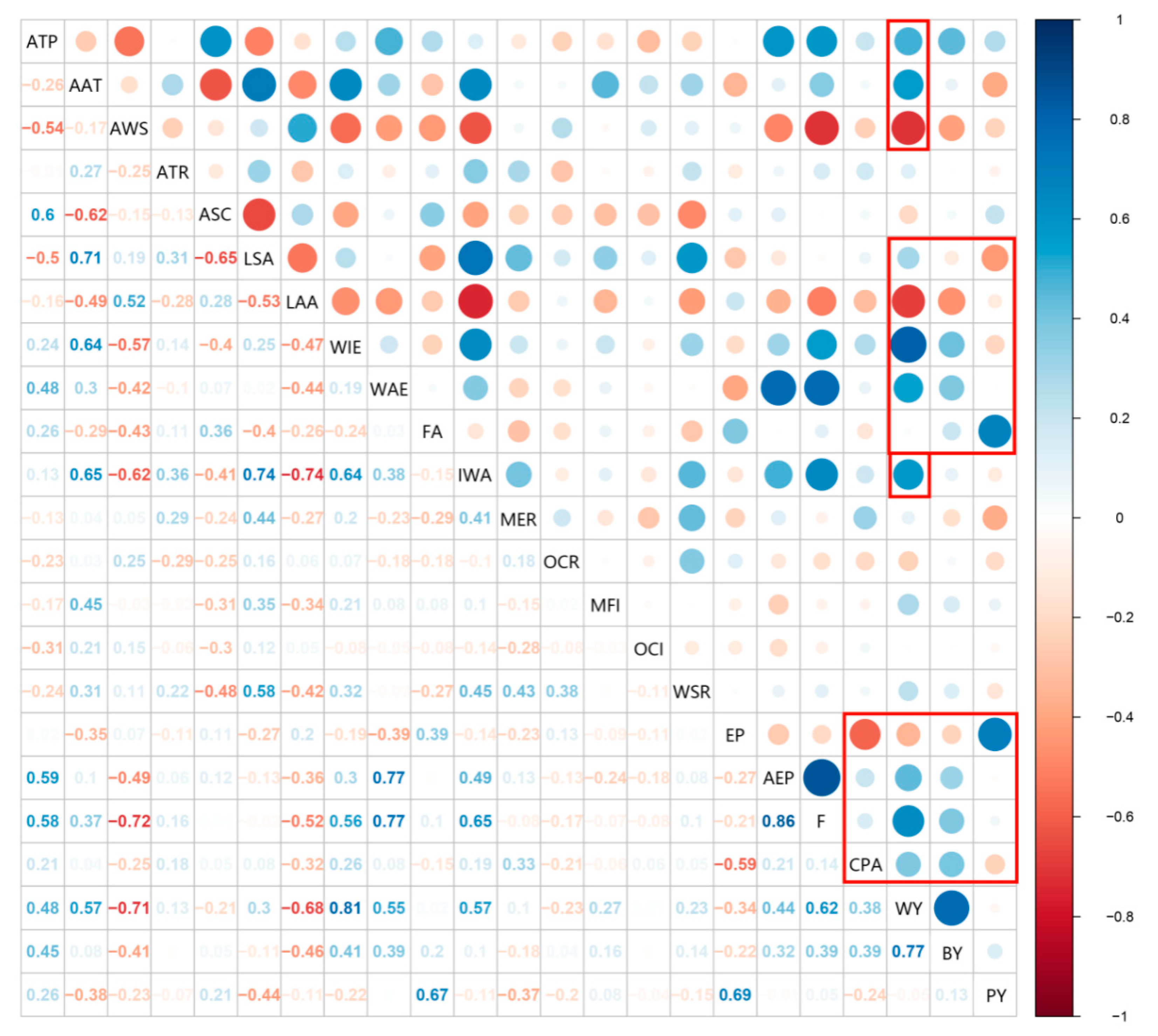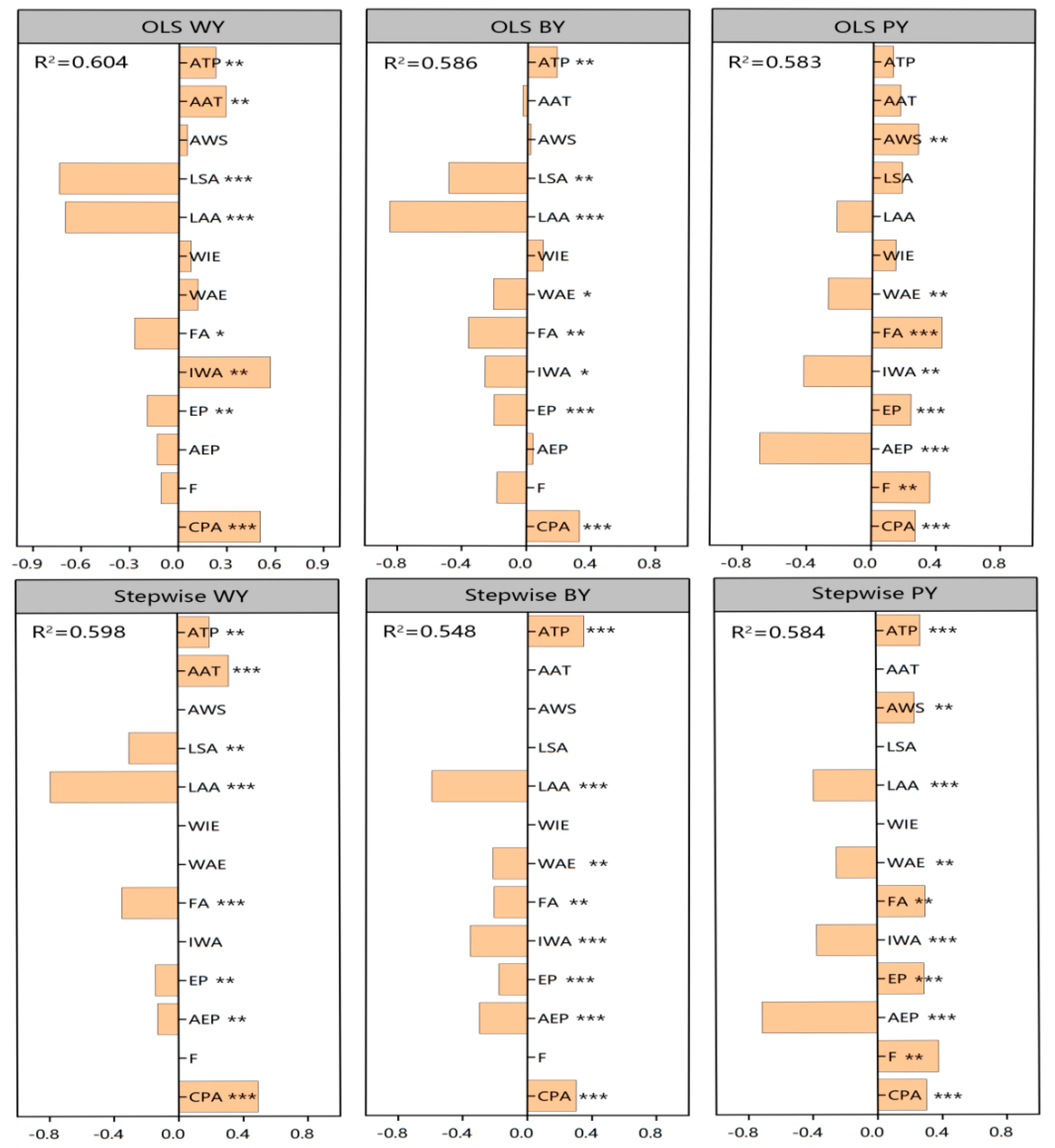Limiting Factors and Environmental Adaptability for Staple Crops in Kazakhstan
Abstract
1. Introduction
2. Food Production Status in Kazakhstan
2.1. Food Productivity Level in Kazakhstan
2.2. Food Production Structure in Kazakhstan
2.3. Food Production Layout in Kazakhstan
3. Materials and Methods
3.1. Overview of Yield Gap
3.2. Methods
3.2.1. Analysis of Influencing Factors
3.2.2. Analysis of Environmental Adaptability
3.3. Data Sources
| Cxategories | Factors | Abbreviations (Unit) | Data Processing | Descriptive Statistics |
|---|---|---|---|---|
| Climatic factors [37] | Annual total precipitation | ATP (mm) | Raw data from yearbooks. | Mean: 309.76; SD: 136.76; Min: 78; Max: 984. |
| Annual average temperature | AAT (°C) | Mean: 7.06; SD: 3.62; Min: 0.70; Max: 13.60. | ||
| Annual average wind speed | AWS (m/s) | Mean: 2.81; SD: 1.01; Min: 0.00; Max: 4.40. | ||
| Annual total radiation | ATR (106 cal/cm2) | Mean: 135.41; SD: 32.10; Min: 80.40; Max: 224.83. | ||
| Annual snow cover | ASC (cm) | Mean: 25.2; SD: 13.42; Min: 1; Max: 55. | ||
| Soil health factors [38,39] | Land salinization | LSA (%) | Proportions of salinized, alkalized, wind-eroded, and water-eroded (excessive humidity, swamp, and washout) areas in agricultural land. | Mean: 18.42; SD: 15.54; Min: 5.52; Max: 58.13. |
| Land alkalization | LAA (%) | Mean: 25.27; SD: 15.19; Min: 3.45; Max: 55.67. | ||
| Wind erosion | WIE (%) | Mean: 13.53; SD: 11.78; Min: 0.00; Max: 34.39. | ||
| Water erosion | WAE (%) | Mean: 4.40; SD: 2.53; Min: 0.42; Max: 10.64. | ||
| Fragmentation | FA (%) | Mean: 16.98; SD: 15.75; Min: 1.40; Max: 53.53. | ||
| Management factors | Agricultural irrigation water | IWA (m3/ha); | Irrigation water (IW) divided by crop area; | Mean: 2785.04; SD: 5381.74; Min: 0.94; Max: 23,511.74. |
| Mineral fertilizer application ratio | MFR (%) | Ratio of mineral fertilizer and organic fertilizer application area to crop area, respectively. | Mean: 6.42; SD: 6.80; Min: 0.09; Max: 27.22. | |
| Organic compound application ratio | OCR (%) | Mean: 0.11; SD: 0.18; Min: 0.00; Max: 1.04. | ||
| Mineral fertilizer application intensity | MFI (t/ha) | Raw data from yearbooks. | Mean: 171.67; SD: 249.90; Min: 3.10; Max: 1611.80. | |
| Organic compound application intensity | OCI (t/ha) | Mean: 16.24; SD: 22.85; Min: 0.10; Max: 144.40. | ||
| Socioeconomic factors [40] | Rural water supply services | WSR (%) | Raw data from yearbooks. | Mean: 87.88; SD: 5.75; Min: 75.70; Max: 100.00. |
| Electricity production | EP (kW·h/ha) | Power generation (PG) divided by state area. | Mean: 396.71; SD: 759.70; Min: 34.60; Max: 3657.30. | |
| Agricultural economic practitioners | AEP (company/103 ha) | Numbers of agricultural economic activity participants and offices (AEPO) and farmers (TF) divided by crop area. | Mean: 7.30; SD: 25.54; Min: 0.09; Max: 160.00. | |
| Farmers | F (company/103 ha) | Mean: 136.34; SD: 418.43; Min: 0.59; Max: 2660.00. | ||
| Crop production profit margin | CPA (%) | Raw data from yearbooks. | Mean: 29.40; SD: 20.81; Min: −21.70; Max: 80.90. |
4. Results
4.1. Influencing Factors of Food Productivity in Kazakhstan
4.2. Environmental Adaptability of Staple Crops in Kazakhstan
5. Discussion
5.1. Model Evaluation
5.2. Results Analysis and Related Research
5.3. Countermeasures and Suggestions
- (1)
- Agricultural technology development and introduction in arid areas.
- (2)
- Adjustment of crop production distribution.
- (3)
- Organic fertilizer and drought-resistant crop varieties should be promoted.
- (4)
- Agricultural technology training and service promotion.
6. Conclusions
Author Contributions
Funding
Institutional Review Board Statement
Informed Consent Statement
Data Availability Statement
Conflicts of Interest
References
- Garbero, A.; Jäckering, L. The Potential of Agricultural Programs for Improving Food Security: A Multi-Country Perspective. Glob. Food Secur. 2021, 29, 100529. [Google Scholar] [CrossRef]
- Mc Carthy, U.; Uysal, I.; Badia-Melis, R.; Mercier, S.; O’Donnell, C.; Ktenioudaki, A. Global Food Security—Issues, Challenges and Technological Solutions. Trends Food Sci. Technol. 2018, 77, 11–20. [Google Scholar] [CrossRef]
- Pereira, A.; Handa, S.; Holmqvist, G. Estimating the Prevalence of Food Insecurity of Households with Children under 15 Years, across the Globe. Glob. Food Secur. 2021, 28, 100482. [Google Scholar] [CrossRef]
- Tian, X.; Engel, B.A.; Qian, H.; Hua, E.; Sun, S.; Wang, Y. Will Reaching the Maximum Achievable Yield Potential Meet Future Global Food Demand? J. Clean. Prod. 2021, 294, 126285. [Google Scholar] [CrossRef]
- Swinnen, J.; Burkitbayeva, S.; Schierhorn, F.; Prishchepov, A.V.; Müller, D. Production Potential in the “Bread Baskets” of Eastern Europe and Central Asia. Glob. Food Secur. 2017, 14, 38–53. [Google Scholar] [CrossRef]
- FAOSTAT. Available online: https://www.fao.org/giews/countrybrief/country.jsp?code=KAZ (accessed on 30 July 2022).
- Dara, A.; Baumann, M.; Freitag, M.; Hölzel, N.; Hostert, P.; Kamp, J.; Müller, D.; Prishchepov, A.V.; Kuemmerle, T. Annual Landsat Time Series Reveal Post-Soviet Changes in Grazing Pressure. Remote Sens. Environ. 2020, 239, 111667. [Google Scholar] [CrossRef]
- Lazzat, Y.; Aigerim, O.; Daniya, N. The Ecological and Legal Aspects of Ensuring the Food Security of the Republic of Kazakhstan Under the Transition to a “Green” Economy. Procedia-Soc. Behav. Sci. 2014, 143, 971–975. [Google Scholar] [CrossRef][Green Version]
- Tazhibaev, S.; Musabekov, K.; Yesbolova, A.; Ibraimova, S.; Mergenbayeva, A.; Sabdenova, Z.; Seidahmetov, M. Issues in the Development of the Livestock Sector in Kazakhstan. Procedia-Soc. Behav. Sci. 2014, 143, 610–614. [Google Scholar] [CrossRef]
- Wang, D.; Li, S.; Toktarbek, S.; Jiakula, N.; Ma, P.; Feng, Y. Research on the Coordination between Agricultural Production and Environmental Protection in Kazakhstan Based on the Rationality of the Objective Weighting Method. Sustainability 2022, 14, 3700. [Google Scholar] [CrossRef]
- Xu, H.; Zhang, X.; Ye, Z.; Jiang, L.; Qiu, X.; Tian, Y.; Zhu, Y.; Cao, W. Machine Learning Approaches Can Reduce Environmental Data Requirements for Regional Yield Potential Simulation. Eur. J. Agron. 2021, 129, 126335. [Google Scholar] [CrossRef]
- Ding, Y.K.; Li, Y.P.; Liu, Y.R. Spatial-Temporal Assessment of Agricultural Virtual Water and Uncertainty Analysis: The Case of Kazakhstan (2000–2016). Sci. Total Environ. 2020, 724, 138155. [Google Scholar] [CrossRef] [PubMed]
- Kim, S.J.; Park, S.; Lee, S.J.; Shaimerdenova, A.; Kim, J.; Park, E.; Lee, W.; Kim, G.S.; Kim, N.; Kim, T.H.; et al. Developing Spatial Agricultural Drought Risk Index with Controllable Geo-Spatial Indicators: A Case Study for South Korea and Kazakhstan. Int. J. Disaster Risk Reduct. 2021, 54, 102056. [Google Scholar] [CrossRef]
- Barrett, T.; Feola, G.; Krylova, V.; Khusnitdinova, M. The Application of Rapid Appraisal of Agricultural Innovation Systems (RAAIS) to Agricultural Adaptation to Climate Change in Kazakhstan: A Critical Evaluation. Agric. Syst. 2017, 151, 106–113. [Google Scholar] [CrossRef]
- Agriculture—Crop Production Yield (Metric Tons)—Cereal. 2020. Available online: https://cn.knoema.com//atlas/topics/Agriculture (accessed on 30 July 2022).
- Liao, M.; Wei, F. Analysis of grain production and development potentiality in Central Asia based on GAEZ method. J. Nat. Resour. 2021, 36, 582. [Google Scholar] [CrossRef]
- Agriculture—Trade Export Volume—Cereal. 2020. Available online: https://cn.knoema.com//atlas/topics/Agriculture (accessed on 30 July 2022).
- Kazakhstan National Bureau of Strategic Statistics. Agriculture, Forestry and Fisheries in the Republic of Kazakhstan. Available online: https://stat.gov.kz/official/industry/14/publication (accessed on 5 June 2021).
- Dias, H.B.; Sentelhas, P.C. Sugarcane Yield Gap Analysis in Brazil—A Multi-Model Approach for Determining Magnitudes and Causes. Sci. Total Environ. 2018, 637–638, 1127–1136. [Google Scholar] [CrossRef]
- Barker, R.K.; Gomez, A.; Herdi, R.W. Farm-Level Constraints to High Rice Yields in Asia: 1974-77; International Rice Research Institute: Los Banos, CA, USA, 1979. [Google Scholar]
- de Datta, S.K. Principles and Practices of Rice Production; Wiley-Interscience Production: New York, NY, USA, 1981. [Google Scholar]
- Fresco, L.O. Issues in Farming Systems Research. J. Agric. Sci. 1984, 32, 253–261. [Google Scholar] [CrossRef]
- de Bie, C.A.J.M. Comparative Performance Analysis of Agro-Ecosystems; Wageningen University and Research: Wageningen, The Netherlands, 2000. [Google Scholar]
- Liu, B.; Chen, X.; Cui, Z.; Meng, Q.; Zhao, M. Research Advance in Yield Potential and Yield Gap of three major cereal crops. Chin. J. Eco-Agric. 2015, 23, 525–534. [Google Scholar] [CrossRef]
- Fischer, R.A.; Edmeades, G.O. Breeding and Cereal Yield Progress. Crop Sci. 2010, 50, S-85–S-98. [Google Scholar] [CrossRef]
- Christina, M.; Jones, M.-R.; Versini, A.; Mézino, M.; Le Mézo, L.; Auzoux, S.; Soulié, J.C.; Poser, C.; Gérardeaux, E. Impact of Climate Variability and Extreme Rainfall Events on Sugarcane Yield Gap in a Tropical Island. Field Crops Res. 2021, 274, 108326. [Google Scholar] [CrossRef]
- Liu, Y.; Li, Y.; Lü, T.; Xing, J.; Xu, T.; Cai, W.; Zhang, Y.; Zhao, J.; Wang, R. The Priority of Management Factors for Reducing the Yield Gap of Summer Maize in the North of Huang-Huai-Hai Region, China. J. Integr. Agric. 2021, 20, 450–459. [Google Scholar] [CrossRef]
- González-Quintero, R.; van Wijk, M.T.; Ruden, A.; Gómez, M.; Pantevez, H.; Castro-Llanos, F.; Notenbaert, A.; Arango, J. Yield Gap Analysis to Identify Attainable Milk and Meat Productivities and the Potential for Greenhouse Gas Emissions Mitigation in Cattle Systems of Colombia. Agric. Syst. 2022, 195, 103303. [Google Scholar] [CrossRef]
- Senthilkumar, K. Closing Rice Yield Gaps in Africa Requires Integration of Good Agricultural Practices. Field Crops Res. 2022, 285, 108591. [Google Scholar] [CrossRef]
- Rong, L.; Gong, K.; Duan, F.; Li, S.; Zhao, M.; He, J.; Zhou, W.; Yu, Q. Yield Gap and Resource Utilization Efficiency of Three Major Food Crops in the World—A Review. J. Integr. Agric. 2021, 20, 349–362. [Google Scholar] [CrossRef]
- van Dijk, M.; Morley, T.; van Loon, M.; Reidsma, P.; Tesfaye, K.; van Ittersum, M.K. Reducing the Maize Yield Gap in Ethiopia: Decomposition and Policy Simulation. Agric. Syst. 2020, 183, 102828. [Google Scholar] [CrossRef]
- Wang, X.; Dietrich, J.P.; Lotze-Campen, H.; Biewald, A.; Stevanović, M.; Bodirsky, B.L.; Brümmer, B.; Popp, A. Beyond Land-Use Intensity: Assessing Future Global Crop Productivity Growth under Different Socioeconomic Pathways. Technol. Forecast. Soc. Chang. 2020, 160, 120208. [Google Scholar] [CrossRef]
- Wu, F.; Xu, P.; Guo, H.; Zhang, Z. Advance in research regarding the yield gap and resource use efficiency of winter wheat cultivation and the related regulatory approaches. Chin. J. Eco-Agric. 2020, 28, 1551–1567. [Google Scholar] [CrossRef]
- Habib, A.; Khan, M.A.; Popp, J.; Rákos, M. The Influence of Operating Capital and Cash Holding on Firm Profitability. Economies 2022, 10, 69. [Google Scholar] [CrossRef]
- Niu, G.; Ji, Y.; Zhang, Z.; Wang, W.; Chen, J.; Yu, P. Clustering Analysis of Typical Scenarios of Island Power Supply System by Using Cohesive Hierarchical Clustering Based K-Means Clustering Method. Energy Rep. 2021, 7, 250–256. [Google Scholar] [CrossRef]
- Kazakhstan National Bureau of Strategic Statistics. Environmental Protection and Sustainable Development of Kazakhstan. Available online: https://stat.gov.kz/official/industry/157/publication (accessed on 5 June 2021).
- Asante, P.A.; Rahn, E.; Zuidema, P.A.; Rozendaal, D.M.A.; van der Baan, M.E.G.; Läderach, P.; Asare, R.; Cryer, N.C.; Anten, N.P.R. The Cocoa Yield Gap in Ghana: A Quantification and an Analysis of Factors That Could Narrow the Gap. Agric. Syst. 2022, 201, 103473. [Google Scholar] [CrossRef]
- Mussgnug, F.; Becker, M.; Son, T.T.; Buresh, R.J.; Vlek, P.L.G. Yield Gaps and Nutrient Balances in Intensive, Rice-Based Cropping Systems on Degraded Soils in the Red River Delta of Vietnam. Field Crops Res. 2006, 98, 127–140. [Google Scholar] [CrossRef]
- Casanova, D.; Goudriaan, J.; Bouma, J.; Epema, G.F. Yield Gap Analysis in Relation to Soil Properties in Direct-Seeded Flooded Rice. Geoderma 1999, 91, 191–216. [Google Scholar] [CrossRef]
- Liu, Z.; Yang, X.; Lin, X.; Hubbard, K.G.; Lv, S.; Wang, J. Maize Yield Gaps Caused by Non-Controllable, Agronomic, and Socioeconomic Factors in a Changing Climate of Northeast China. Sci. Total Environ. 2016, 541, 756–764. [Google Scholar] [CrossRef] [PubMed]
- Schreefel, L.; Schulte, R.P.O.; de Boer, I.J.M.; Schrijver, A.P.; van Zanten, H.H.E. Regenerative Agriculture—The Soil Is the Base. Glob. Food Secur. 2020, 26, 100404. [Google Scholar] [CrossRef]
- Pavlova, V.N.; Varcheva, S.E.; Bokusheva, R.; Calanca, P. Modelling the Effects of Climate Variability on Spring Wheat Productivity in the Steppe Zone of Russia and Kazakhstan. Ecol. Model. 2014, 277, 57–67. [Google Scholar] [CrossRef]
- Schierhorn, F.; Hofmann, M.; Adrian, I.; Bobojonov, I.; Müller, D. Spatially Varying Impacts of Climate Change on Wheat and Barley Yields in Kazakhstan. J. Arid Environ. 2020, 178, 104164. [Google Scholar] [CrossRef]
- Bobojonov, I.; Aw-Hassan, A. Impacts of Climate Change on Farm Income Security in Central Asia: An Integrated Modeling Approach. Agric. Ecosyst. Environ. 2014, 188, 245–255. [Google Scholar] [CrossRef]
- Karatayev, M.; Rivotti, P.; Sobral Mourão, Z.; Konadu, D.D.; Shah, N.; Clarke, M. The Water-Energy-Food Nexus in Kazakhstan: Challenges and Opportunities. Energy Procedia 2017, 125, 63–70. [Google Scholar] [CrossRef]
- Salnikov, V.; Turulina, G.; Polyakova, S.; Petrova, Y.; Skakova, A. Climate Change in Kazakhstan during the Past 70 Years. Quat. Int. 2015, 358, 77–82. [Google Scholar] [CrossRef]
- Spivak, L.; Arkhipkin, O.; Pankratov, V.; Vitkovskaya, I.; Sagatdinova, G. Space Monitoring of Floods in Kazakhstan. Math. Comput. Simul. 2004, 67, 365–370. [Google Scholar] [CrossRef]
- Liu, X.; Chen, C.; Sun, J.; Wang, X. Development of Natural Fiber-Based Degradable Nonwoven Mulch from Recyclable Mill Waste. Waste Manag. 2021, 121, 432–440. [Google Scholar] [CrossRef]
- Wang, D.; Li, R.; Gao, G.; Jiakula, N.; Toktarbek, S.; Li, S.; Ma, P. Impact of Climate Change on Food Security in Kazakhstan. Agriculture 2022, 12, 1087. [Google Scholar] [CrossRef]
- Hu, Y.; Han, Y.; Zhang, Y. Land Desertification and Its Influencing Factors in Kazakhstan. J. Arid Environ. 2020, 180, 104203. [Google Scholar] [CrossRef]
- Fischer, H.W.; Reddy, N.L.N.; Rao, M.L.S. Can More Drought Resistant Crops Promote More Climate Secure Agriculture? Prospects and Challenges of Millet Cultivation in Ananthapur, Andhra Pradesh. World Dev. Perspect. 2016, 2, 5–10. [Google Scholar] [CrossRef]
- Meyfroidt, P.; Schierhorn, F.; Prishchepov, A.V.; Müller, D.; Kuemmerle, T. Drivers, Constraints and Trade-Offs Associated with Recultivating Abandoned Cropland in Russia, Ukraine and Kazakhstan. Glob. Environ. Chang. 2016, 37, 1–15. [Google Scholar] [CrossRef]
- Zakaria, A.; Azumah, S.B.; Appiah-Twumasi, M.; Dagunga, G. Adoption of Climate-Smart Agricultural Practices among Farm Households in Ghana: The Role of Farmer Participation in Training Programmes. Technol. Soc. 2020, 63, 101338. [Google Scholar] [CrossRef]
- Castillo, C.; Pérez, R.; Vallejo-Orti, M. The Impact of Recent Gully Filling Practices on Wheat Yield at the Campiña Landscape in Southern Spain. Soil Tillage Res. 2021, 212, 105041. [Google Scholar] [CrossRef]
- Zhang, T.; Song, H.; Zhou, B.; Wang, L.; Yang, A.; Wang, T.; Kong, H.; Chen, Y.; Zhou, S.; Fu, S. Effects of Air Pollutants and Their Interactive Environmental Factors on Winter Wheat Yield. J. Clean. Prod. 2021, 305, 127230. [Google Scholar] [CrossRef]






| Factor | OLS/WY | Stepwise/WY | OLS/BY | Stepwise/BY | OLS/PY | Stepwise/PY |
|---|---|---|---|---|---|---|
| ATP | 2.893 | 2.057 | 2.979 | 2.273 | 2.712 | 2.537 |
| AAT | 6.488 | 2.127 | 7.453 | / | 6.583 | / |
| AWS | 4.097 | / | 4.688 | / | 4.325 | 3.865 |
| LSA | 16.042 | 4.534 | 14.671 | / | 11.533 | / |
| LAA | 10.303 | 5.151 | 9.929 | 4.66 | 9.673 | 4.516 |
| WIE | 12.906 | / | 7.224 | / | 7.112 | / |
| WAE | 4.337 | / | 4.371 | 3.382 | 4.295 | 3.937 |
| FA | 8.487 | 3.071 | 8.76 | 3.041 | 8.718 | 6.013 |
| IWA | 16.98 | / | 8.419 | 4.172 | 9.17 | 5.968 |
| EP | 2.454 | 1.221 | 1.791 | 1.27 | 1.825 | 1.327 |
| AEP | 25.168 | 1.365 | 32.141 | 1.766 | 7.13 | 7.071 |
| F | 37.237 | / | 38 | / | 7.922 | 7.655 |
| CPA | 1.821 | 1.701 | 2.22 | 1.873 | 1.95 | 1.819 |
Publisher’s Note: MDPI stays neutral with regard to jurisdictional claims in published maps and institutional affiliations. |
© 2022 by the authors. Licensee MDPI, Basel, Switzerland. This article is an open access article distributed under the terms and conditions of the Creative Commons Attribution (CC BY) license (https://creativecommons.org/licenses/by/4.0/).
Share and Cite
Wang, D.; Gao, G.; Li, R.; Toktarbek, S.; Jiakula, N.; Feng, Y. Limiting Factors and Environmental Adaptability for Staple Crops in Kazakhstan. Sustainability 2022, 14, 9980. https://doi.org/10.3390/su14169980
Wang D, Gao G, Li R, Toktarbek S, Jiakula N, Feng Y. Limiting Factors and Environmental Adaptability for Staple Crops in Kazakhstan. Sustainability. 2022; 14(16):9980. https://doi.org/10.3390/su14169980
Chicago/Turabian StyleWang, Danmeng, Guoxi Gao, Ruolan Li, Shynggys Toktarbek, Nueryia Jiakula, and Yongzhong Feng. 2022. "Limiting Factors and Environmental Adaptability for Staple Crops in Kazakhstan" Sustainability 14, no. 16: 9980. https://doi.org/10.3390/su14169980
APA StyleWang, D., Gao, G., Li, R., Toktarbek, S., Jiakula, N., & Feng, Y. (2022). Limiting Factors and Environmental Adaptability for Staple Crops in Kazakhstan. Sustainability, 14(16), 9980. https://doi.org/10.3390/su14169980






